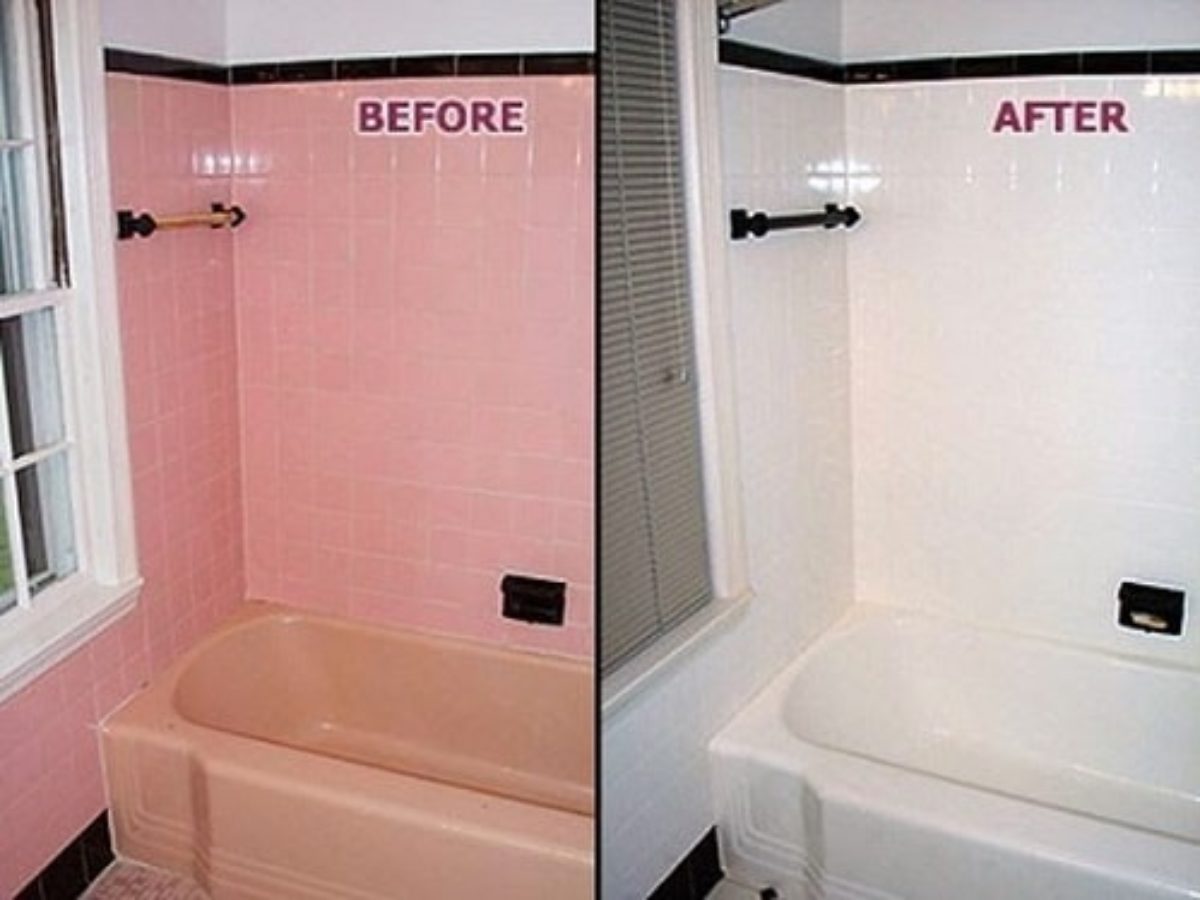Spray painting bathroom floor tiles is a cost-effective and transformative way to update the look of your bathroom without the need for a complete renovation. This method allows you to refresh old, outdated tiles with a modern finish, making your bathroom look brand new. In today’s article, we will cover everything you need to know about spray painting bathroom floor tiles, from preparation to finishing touches.

Preparing the Bathroom Floor Tiles for Spray Painting
Cleaning the Tiles
The first step in preparing your bathroom floor tiles for spray painting is a thorough cleaning. Use a strong cleaner or a mixture of water and mild detergent to scrub the tiles and grout lines. Pay special attention to any areas with mold, mildew, or soap scum buildup. Use a scrub brush to ensure that all dirt and grime are removed. Rinse the tiles thoroughly with clean water and allow them to dry completely before proceeding.
Repairing Damaged Tiles
Inspect the tiles for any cracks, chips, or loose grout. It’s important to repair these issues before painting to ensure a smooth and durable finish. Use a tile repair kit to fix any minor damages. For loose or missing grout, apply fresh grout and allow it to cure according to the manufacturer’s instructions. If any tiles are severely damaged, consider replacing them before starting the painting process.
Sanding the Surface
Sanding the tiles helps to create a rough surface that the paint can adhere to. Use a fine-grit sandpaper to lightly sand the entire surface of the tiles. This will help the primer and paint bond better with the tiles. Be sure to sand evenly and avoid applying too much pressure, which could damage the tiles. After sanding, wipe the tiles with a damp cloth to remove any dust and allow them to dry.

Masking and Protecting Surrounding Areas
Before you begin painting, it’s essential to protect the surrounding areas from overspray. Use painter’s tape to mask off the edges of the floor, the baseboards, and any fixtures that you do not want to paint. Cover the walls, bathtub, toilet, and sink with plastic sheeting or drop cloths. Ensuring that these areas are well-protected will help you achieve a clean, professional-looking finish.
Choosing the Right Primer
Selecting the right primer is crucial for the success of your spray painting project. Look for a primer that is specifically designed for use on tiles and can handle the moisture and wear typical of a bathroom environment. A good quality primer will help the paint adhere better and provide a more durable finish. Apply the primer using smooth, even strokes, and allow it to dry according to the manufacturer’s instructions.
Ventilation and Safety Precautions
Spray painting indoors requires proper ventilation to avoid inhaling fumes. Open windows and use fans to ensure good air circulation. If your bathroom does not have adequate ventilation, consider using a respirator mask to protect yourself from fumes. Additionally, wear safety goggles and gloves to protect your eyes and skin from the paint and primer.
Choosing the Right Paint and Tools
Types of Paint Suitable for Tiles
When it comes to painting bathroom floor tiles, not all paints are created equal. Epoxy paint is a popular choice due to its durability and resistance to moisture, stains, and abrasion. Another option is tile-specific paint, which is formulated to adhere to the smooth surface of tiles and withstand the rigors of a bathroom environment. Both types of paint are available in spray cans, making them convenient for this project.
Selecting the Right Color and Finish
Choosing the right color and finish is important for achieving the desired look in your bathroom. Light colors can make a small bathroom feel larger and more open, while darker colors can add a touch of elegance and sophistication. For the finish, consider whether you want a glossy, satin, or matte look. Glossy finishes are easier to clean but may show imperfections more easily, while matte finishes can hide flaws but may require more maintenance.
Spray Paint Equipment and Accessories
To achieve a professional finish, it’s essential to use the right spray paint equipment and accessories. A high-quality spray paint can with a fine nozzle will help you apply the paint evenly and avoid drips. Consider using a spray paint trigger handle for better control and reduced hand fatigue. Additionally, have plenty of painter’s tape, plastic sheeting, and drop cloths on hand to protect surrounding areas.
Testing the Paint
Before committing to painting the entire floor, it’s a good idea to test the paint on a small, inconspicuous area of the tile. This will allow you to see how the paint adheres and how the color looks in your bathroom lighting. If you’re satisfied with the test area, proceed with confidence to paint the rest of the tiles. If not, you may need to adjust your choice of paint or color.
Calculating the Amount of Paint Needed
Determining the amount of paint needed for your project will help you avoid running out halfway through. Measure the total area of the tiles you plan to paint and consult the paint manufacturer’s coverage guidelines. It’s always a good idea to buy a little more than you think you’ll need to account for any touch-ups or additional coats. Having extra paint on hand can save you time and frustration.
Ensuring Compatibility with Existing Tile Material
Not all tiles are the same, and some may require special considerations when painting. Porcelain, ceramic, and natural stone tiles can all be painted, but they may require different primers or preparation techniques. Ensure that the paint and primer you choose are compatible with the type of tile you have. If in doubt, consult with a professional or the paint manufacturer for advice on the best products to use.
The Spray Painting Process
Setting Up the Workspace
Before you begin spray painting, set up your workspace to ensure a smooth and efficient process. Lay down drop cloths or plastic sheeting to protect the floor and surrounding areas from overspray. Ensure that your bathroom is well-ventilated, either by opening windows and doors or using fans. Organize your tools and materials so that everything you need is within easy reach.
Applying the Primer
Begin by applying a coat of primer to the tiles. Hold the spray can at a consistent distance from the surface, usually about 8-12 inches, and use smooth, even strokes to apply the primer. Work in small sections, overlapping each pass slightly to ensure full coverage. Allow the primer to dry completely according to the manufacturer’s instructions before proceeding to the next step.
First Coat of Paint
Once the primer is dry, you can begin applying the first coat of paint. Again, hold the spray can at a consistent distance and use smooth, even strokes. Start at one end of the room and work your way across, maintaining a wet edge to avoid visible lines. Apply the paint in thin, even coats to prevent drips and ensure a smooth finish. Allow the first coat to dry completely before applying additional coats.
Additional Coats
Depending on the coverage and the desired finish, you may need to apply multiple coats of paint. Follow the manufacturer’s recommendations for drying times between coats. Each additional coat will enhance the durability and appearance of the paint job. Be patient and take your time to ensure each coat is fully dry before applying the next. This will help you achieve a professional and long-lasting finish.
Final Touches
After the final coat of paint has dried, inspect the tiles for any missed spots or uneven areas. Use a small brush or a fine spray nozzle to touch up any imperfections. Remove any painter’s tape carefully while the paint is still slightly tacky to avoid peeling the paint. Allow the paint to cure fully according to the manufacturer’s instructions before using the bathroom.
Sealing the Paint
To enhance the durability and longevity of the paint job, consider applying a clear sealant over the painted tiles. A sealant will provide an extra layer of protection against moisture, stains, and wear. Choose a sealant that is compatible with your paint and suitable for use on floor tiles. Apply the sealant in thin, even coats, following the manufacturer’s instructions, and allow it to dry completely before using the bathroom.
Benefits of Spray Painting Bathroom Floor Tiles
Cost-Effective Renovation
Spray painting bathroom floor tiles is a budget-friendly alternative to replacing them. New tile installation can be expensive and labor-intensive, while spray painting offers a cost-effective way to achieve a fresh, updated look. With the right preparation and materials, you can transform your bathroom at a fraction of the cost of a full renovation.
Quick and Efficient Process
Compared to the time and effort required for tile replacement, spray painting is a relatively quick process. Once the preparation is complete, the actual painting can be done in a matter of hours. This makes it an ideal option for homeowners looking to update their bathroom without the hassle and downtime of a major renovation.
Customizable Aesthetic
Spray painting allows you to customize the look of your bathroom floor tiles to suit your personal style. With a wide range of colors and finishes available, you can create a unique and personalized space. Whether you prefer a classic, neutral look or a bold, modern design, spray painting offers endless possibilities for customization.
Improved Durability
Using high-quality epoxy or tile-specific paint can enhance the durability of your bathroom floor tiles. These paints are designed to withstand moisture, stains, and wear, providing a long-lasting finish. A well-executed paint job can protect your tiles and extend their lifespan, making it a practical solution for busy households.
Easier Maintenance
A freshly painted tile floor is easier to clean and maintain than worn, outdated tiles. The smooth, sealed surface prevents dirt and grime from accumulating in cracks and crevices, making regular cleaning a breeze. Simply sweep or vacuum the floor regularly and wipe down with a damp mop to keep it looking its best.
Increased Property Value
A well-maintained and aesthetically pleasing bathroom can add value to your home. Potential buyers appreciate updated, modern spaces, and a beautifully painted tile floor can make a positive impression. Investing in a high-quality paint job can increase your home’s appeal and potentially boost its market value.
Common Mistakes to Avoid
Inadequate Surface Preparation
Skipping or rushing the preparation process is one of the most common mistakes when spray painting tiles. Proper cleaning, repairing, and sanding are crucial for ensuring good adhesion and a smooth finish. Neglecting these steps can lead to peeling paint and an uneven surface. Take the time to prepare the tiles thoroughly for the best results.
Using the Wrong Type of Paint
Not all paints are suitable for bathroom floor tiles. Using the wrong type of paint can result in poor adhesion, chipping, and a less durable finish. Choose a high-quality epoxy or tile-specific paint designed for use on bathroom floors. These paints are formulated to withstand the moisture and wear typical of a bathroom environment.
Skipping the Primer
Primer is essential for achieving a durable and long-lasting paint job. It helps the paint adhere better and provides a smooth surface for the topcoat. Skipping the primer can compromise the durability of the paint and lead to peeling and flaking. Always use a primer designed for tiles and follow the manufacturer’s instructions for application.
Applying Paint Too Thickly
Applying thick coats of paint in an attempt to cover the tiles quickly can result in drips, runs, and an uneven finish. Thick layers of paint take longer to dry and are more prone to cracking and peeling. Apply the paint in thin, even coats, allowing each coat to dry completely before applying the next. This approach ensures a smooth and durable finish.
Ignoring Environmental Conditions
Environmental factors such as temperature and humidity can affect the paint application and drying process. Painting in extreme temperatures or high humidity can result in poor adhesion and longer drying times. Follow the manufacturer’s recommendations for ideal painting conditions and ensure the bathroom is well-ventilated during the project.
Rushing the Curing Process
Rushing the curing process can lead to damage and a less durable finish. It is essential to allow the paint to cure fully before using the bathroom for heavy traffic or placing rugs and furniture on the floor. Follow the manufacturer’s guidelines for curing times, which can range from several days to a week. Patience during this final step will ensure a long-lasting and resilient finish.
How long does it take to spray paint bathroom floor tiles?
The time it takes to spray paint bathroom floor tiles depends on several factors, including the size of the bathroom, the number of coats applied, and the drying times for the primer and paint. Preparation, including cleaning and repairing the tiles, can take a day or more. Applying the primer and multiple coats of paint can add several more days, with each coat requiring drying time. Overall, the entire process can take from a few days to a week or more, depending on the complexity of the project and drying times.
What type of paint is best for bathroom floor tiles?
Epoxy paint is generally considered the best option for bathroom floor tiles due to its durability, water resistance, and ability to withstand heavy traffic. It forms a strong, adhesive bond with the tiles and provides excellent protection against moisture and stains. Tile-specific paints are also suitable and offer good adhesion and durability. Both types of paint are available in spray cans, making them convenient for this project.
Can I paint over existing painted bathroom floor tiles?
Yes, you can paint over existing painted bathroom floor tiles, but proper preparation is essential. Start by cleaning the tiles thoroughly and sanding the existing paint to create a rough surface for the new paint to adhere to. Repair any cracks or damage, and consider applying a primer designed for previously painted surfaces. Ensure the new paint is compatible with the existing paint type for the best results.
How do I maintain painted bathroom floor tiles?
Maintaining painted bathroom floor tiles involves regular cleaning and prompt attention to spills and stains. Sweep or vacuum the floor regularly to remove dirt and debris. For deeper cleaning, use a damp mop with a mild detergent or a cleaner specifically designed for painted surfaces. Avoid using harsh chemicals or abrasive cleaners that could damage the paint. Place mats or rugs in high-traffic areas to protect the floor and reduce wear.
Is spray painting bathroom floor tiles a DIY project or should I hire a professional?
Spray painting bathroom floor tiles can be a DIY project if you are comfortable with the steps involved and have the necessary tools and materials. However, hiring a professional can ensure the best results, especially for larger or more complex projects. Professionals have the expertise to handle surface preparation, choose the right products, and apply the paint evenly. If you are unsure about any aspect of the project, consulting with a professional can provide peace of mind and a high-quality finish.
What are the benefits of spray painting bathroom floor tiles?
Spray painting bathroom floor tiles offers several benefits, including a cost-effective renovation option, a quick and efficient process, and the ability to customize the look of your bathroom. High-quality paint provides improved durability and easier maintenance, while a well-painted floor can enhance the overall aesthetic appeal of the bathroom. Additionally, a beautifully painted tile floor can increase the value of your home and provide a cost-effective way to update the space
Related Posts:









